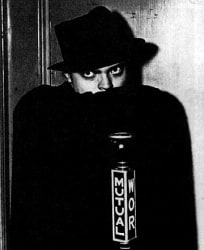![[image]](http://si.wsj.net/public/resources/images/OB-XD030_0418jo_G_20130418123057.jpg) Julian Broad
Julian Broad
Stricken with Tuberculosis as a child, musician Tom Jones recalls his home in Wales.
—Singer Tom Jones, 72, has sold over 100 million records—including "It's Not Unusual" and "What's New Pussycat?" His latest album, "Spirit in the Room" (Rounder), will be released Tuesday. Mr. Jones lives in Beverly Hills, Calif. He spoke with reporter Marc Myers.
I was born in the house of my grandmother in Treforest—a small town in the south of Wales. Nearly everyone in my family had been born in the front room of that two-story home.
When I was 1½, my grandmother on my father's side moved in with her daughter—allowing my family to move into her larger, three-story house about a mile away in Pontypridd. It was convenient, since my father and his brothers worked in the local coal mines. Like our first home, it was a terraced house—one of many identical stone residences that lined the road. Ours stood at the end of a row at the top of a hill on Laura Street.
Terry O'Neill/Hulton Archive/Getty Images
In 1974, Tom Jones visited the streets in Wales, shown here, where he lived as a child. Today he lives in California, where he continues to record and perform.
On the ground floor were three small sitting rooms, with the kitchen in the back. Up a flight of stairs were two more rooms, one behind the next. On the top floor were three small bedrooms—one for my parents and one each for me and my older sister. It was a loving environment, and the neighborhood was filled with family and friends.
But everything changed in 1952, when I turned 12. I began to feel tired and listless, and my mother had trouble getting me up in the morning. When she took me to the doctor, an X-ray showed I had tuberculosis. Fortunately, we caught it early, so my TB wasn't contagious and I could stay at home.
The first plan of action was isolation and rest. My mother moved me down to the middle floor, and I spent the next two years confined to bed. The doctor said I had to relax and that the windows needed to remain open—lowered only slightly in the winter. Blankets and the coal fireplace in the room kept me warm.
Bed was a novelty at first. I didn't have to go to school, which was great since I wasn't a very good student. Later I learned I was dyslexic. But being forbidden to sing during the first year was a real drag. I had started singing early and had been performing in school, at family gatherings and at birthday parties. To keep myself occupied creatively, I sketched and painted with India inks.
My mother was a saint—and very house-proud. She took care of everything. She constantly cleaned and changed the room's walls for me—cutting out pictures of cowboys from magazines and putting them up. From my window, I could see the green valley below. But as good as that view was, I'd grow restless. So my parents routinely moved the bed around to change the scenery.
The radio my parents rented for me was a lifeline. It was a simple, dark-brown model with two dials and two BBC stations. Late at night, you'd hear music from America—blues by Big Bill Broonzy and gospel by Mahalia Jackson. Eventually I also had a rented TV set and watched pop singers on the Saturday-night variety shows—especially Frankie Vaughan. I'd tell myself, "I'm going to be on there one day."
After a year in bed, the doctor let me get up for two hours a day. But all I could do was stand at the front door and wave at my friends going to play or stand standing by the gas lamppost at night. They didn't know how lucky they were. I promised myself that when I could walk to that lamppost, I'd never complain about anything again. Soon my mother bought me a ukulele, and I sang with the window open. People would gather below to listen.
When I had fully recovered in 1954, I moved back upstairs to my bedroom. Three years later, when I was 16, I married and we moved into my wife's family's house. Up until I turned 21, I worked in a local glove factory, then at a paper mill and finally in construction during day so I could sing at night. I used to tell friends I was going to meet Elvis Presley one day. They'd laugh and say, "You're great, Tommy, but be real."
Years later, when my single "With These Hands" was a hit, I traveled to the States in October 1965 to appear on "The Ed Sullivan Show." TV had just gone color, so we had to fly out to Los Angeles, where CBS had color facilities. While I was there, someone asked if I wanted to meet Elvis. We went to Paramount Pictures, where he was filming.
On the set, Elvis saw me and walked over with his hand extended to shake mine. As he got close, he was smiling and singing "With These Hands"—the song I had performed on TV. I couldn't believe it. All I could think of were those years in bed and all those friends who had told me to get real.
A version of this article appeared April 19, 2013, on page M12 in the U.S. edition of The Wall Street Journal, with the headline: Two Years, Confined To One Room.
The Wall Street Journal is becoming the paper to read, it is full of interesting stories, and the Friday paper has a great new section on art, real estate,entertainment and more. I saw this article above on Tom Jones and it brought back memories.....
Tom Jones came to the Carousel Theater in Framingham, in the long ago. The girls were all excited, and during the show, they were throwing panties on the stage. Who would have dreamed?







 "The
Shadow" - One of the most popular radio shows in history. The show went on
the air in August of 1930.
"The
Shadow" - One of the most popular radio shows in history. The show went on
the air in August of 1930. A figure never seen, only heard,
the Shadow was an invincible crime fighter. He possessed many gifts which
enabled him to overcome any enemy. Besides his tremendous strength, he could
defy gravity, speak any language, unravel any code, and become invisible with
his famous ability to "cloud men's minds."
A figure never seen, only heard,
the Shadow was an invincible crime fighter. He possessed many gifts which
enabled him to overcome any enemy. Besides his tremendous strength, he could
defy gravity, speak any language, unravel any code, and become invisible with
his famous ability to "cloud men's minds."












![[image]](http://si.wsj.net/public/resources/images/OB-XD030_0418jo_G_20130418123057.jpg) Julian Broad
Julian Broad
